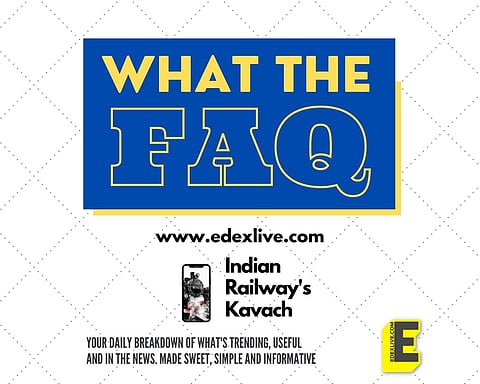

India now has its own Automatic Train Protection (ATP) system — Kavach. Railway Minister Ashwini Vaishnaw, on March 4, said that the technology will be implemented across the entire rail network in the country and will also be exported to the world in the coming years. But what does this mechanism actually do? How much will it cost?
We answer all your queries.
What is Kavach?
This tech has been in development since 2012 and was called the Train Collision Avoidance System (TCAS) at the time. It has been renamed Kavach, which means armour. It is a set of electronic devices and Radio Frequency Identification (RFI) devices that are installed in the locomotives, signalling system and even the tracks. These devices communicate with each other using ultra high radio frequencies and control the brakes of trains and even alert drivers. The system can also alert when a driver jumps signal. The devices also continuously relay information of the road ahead which makes it easier for drivers during fog or low visibility.
How does it work?
Kavach is designed to bring a train to a halt automatically when it notices another train on the same line within a certain distance. Trains will also stop on their own when the digital system notices any manual error like "jumping" of the red signal or any other malfunction. Once the system is activated, all trains within a 5-km range will halt to provide protection for trains on adjacent tracks. Currently, loco-pilots or assistant loco-pilots usually crane their necks out of the window to look out for caution signs and signals, said officials. It also includes stationary equipment to gather signaling and loco inputs and relay them to a central system for seamless communication with the train crew and stations. Kavach is developed by Research Design and Standards Organisation (RDSO) in collaboration with the Indian industry.
How much ground will it cover?
Announced in the 2022 Union Budget as a part of the Atmanirbhar Bharat initiative, 2,000 km of the rail network is planned to be brought under Kavach for safety and capacity augmentation in 2022-23. "In the budget, 2,000 km has been approved and, in subsequent years, Kavach will be deployed in 4,000-5,000 km every year," Vaishnaw told reporters. The target is to install Kavach in 2,000 km and it will be deployed on Delhi-Mumbai and Delhi-Howrah corridors initially. During the development phase, Kavach was implemented for a length of 264 km covering 25 stations across Wadi – Vikarabad – Sanath Nagar and Vikarabad – Bidar sections over South Central Railway. Later, the system has been further extended by an additional 936 km, taking the cumulative deployment of Kavach to 1,200 km, an SCR release said.
What's the cost?
Kavach, which literally means armour, is being promoted by the Railways as the world's cheapest automatic train collision protection system. "If we bring such a technology from Europe it will cost between Rs 1.5 crore to Rs 2 crore per kilometre to operate while Kavach, which is indigenously developed Automatic Train Protection system will cost between Rs 40 lakh to Rs 50 lakh per km and is a step ahead when compared to the technology offered by other similar systems," said the minister.
